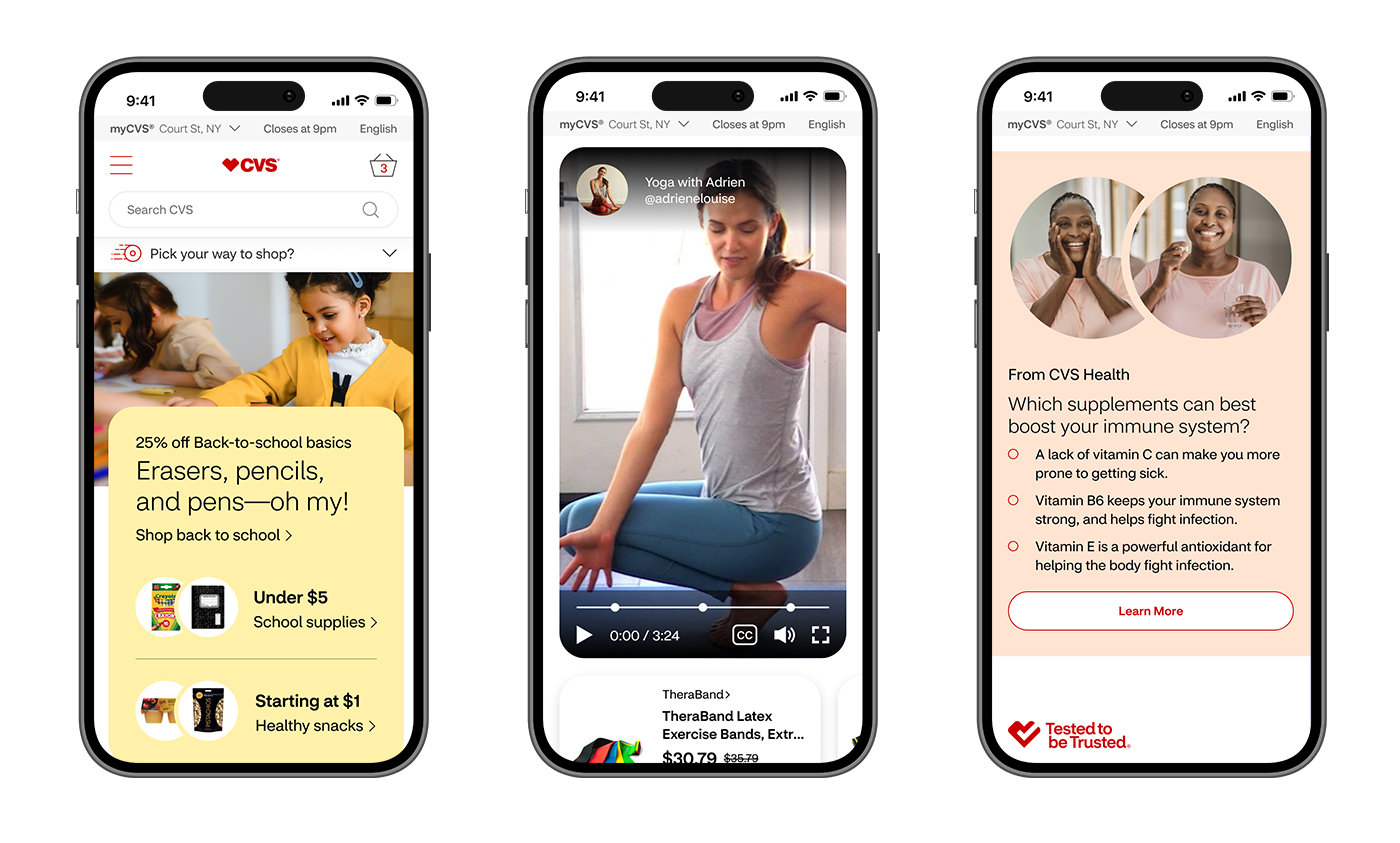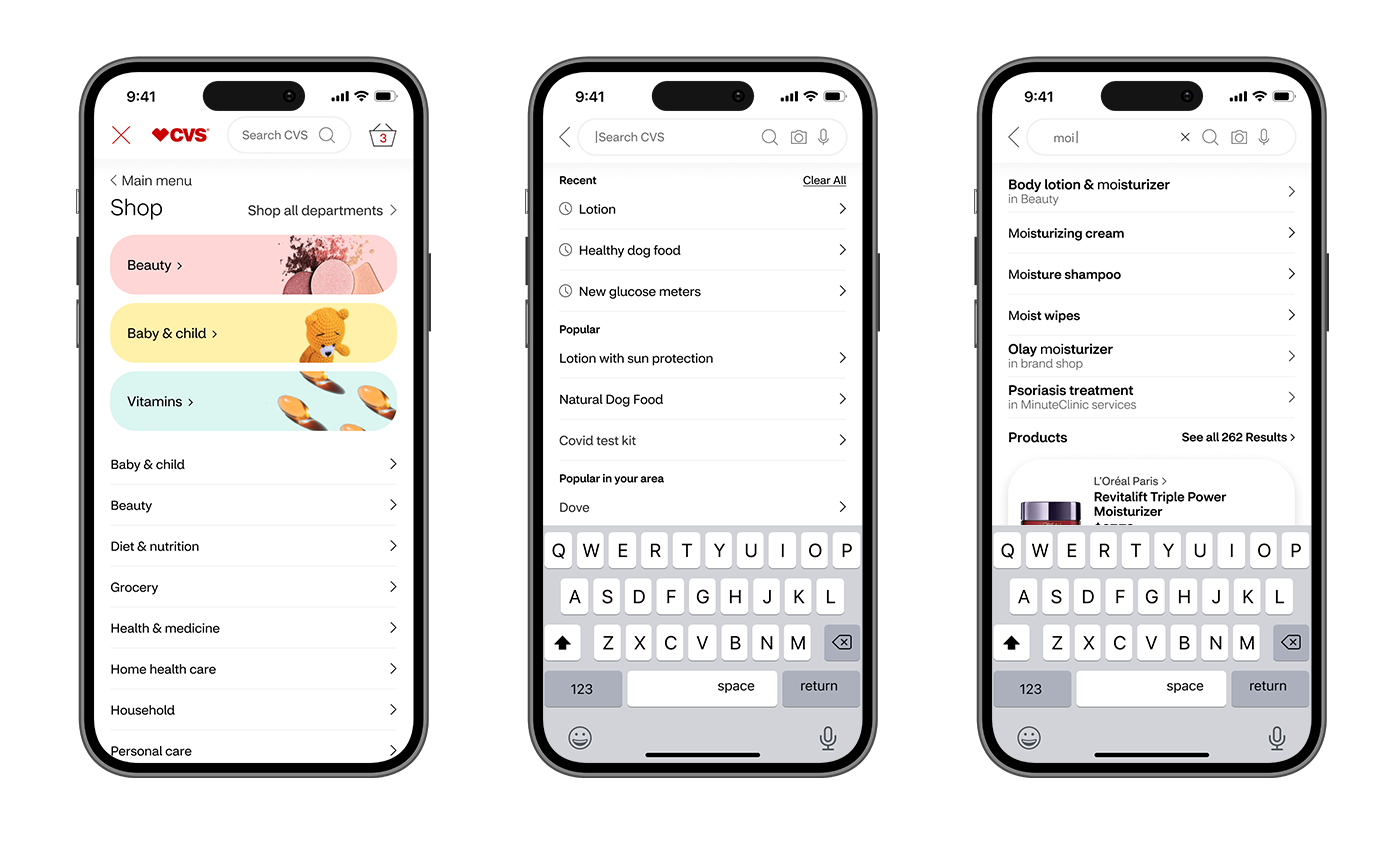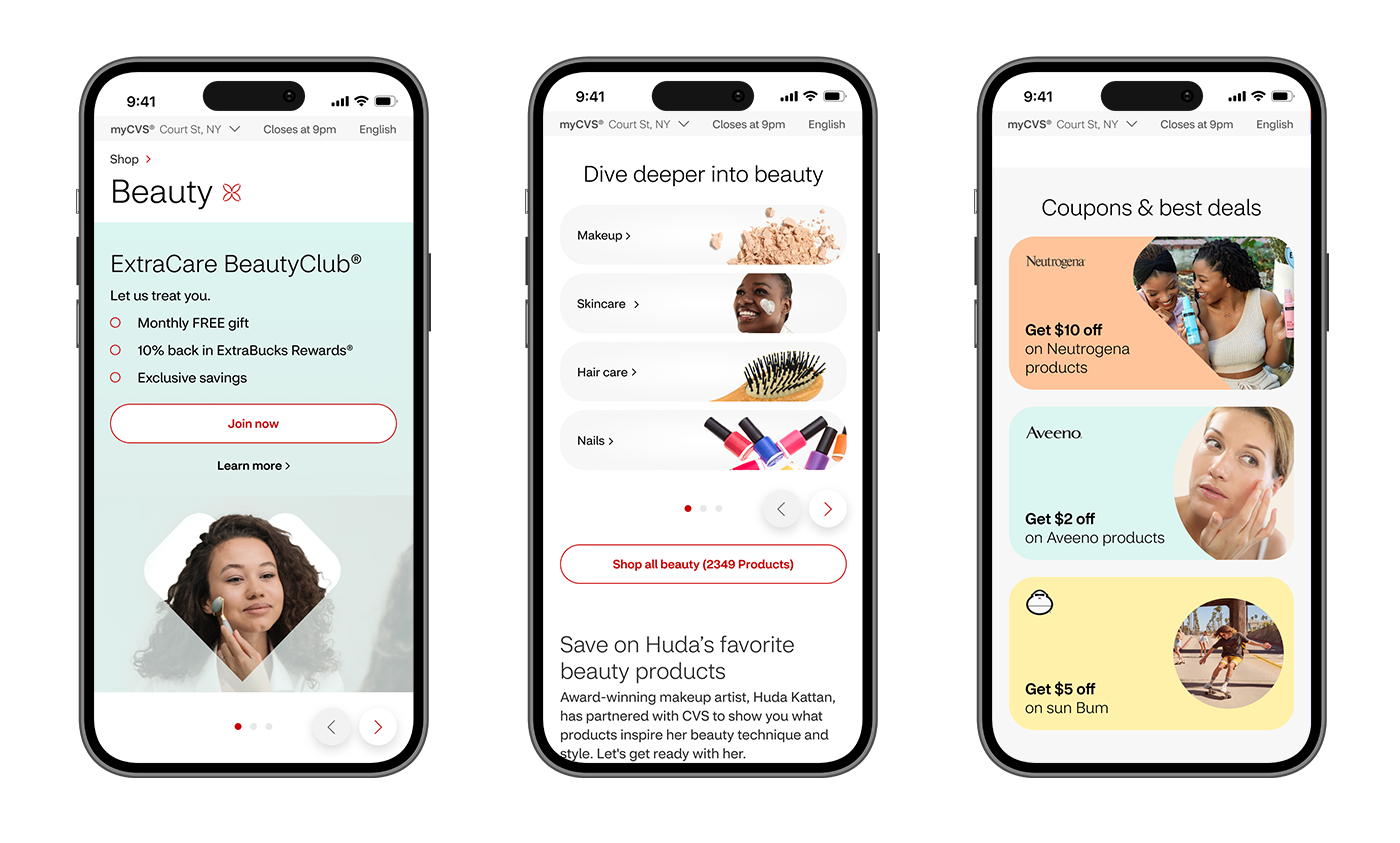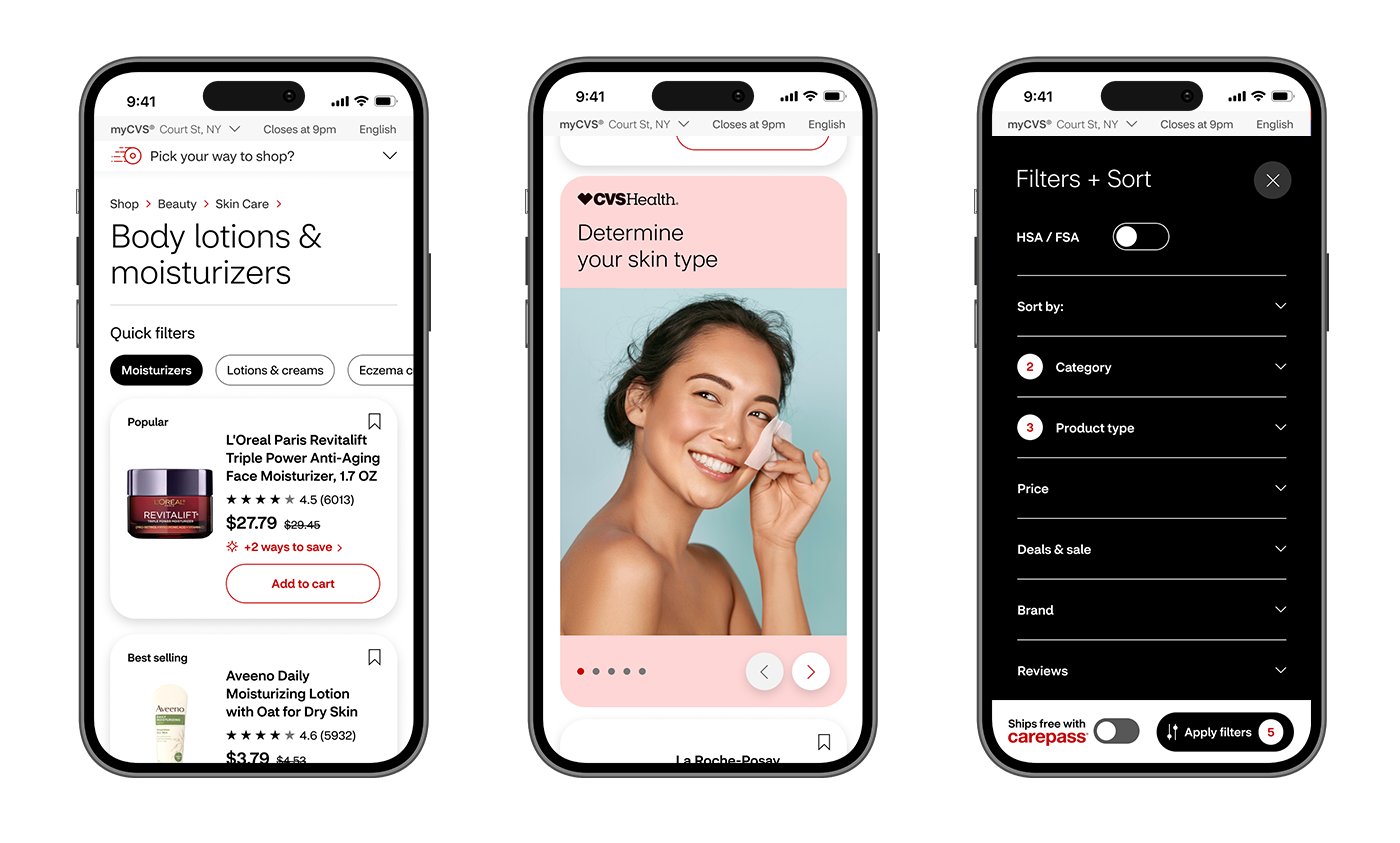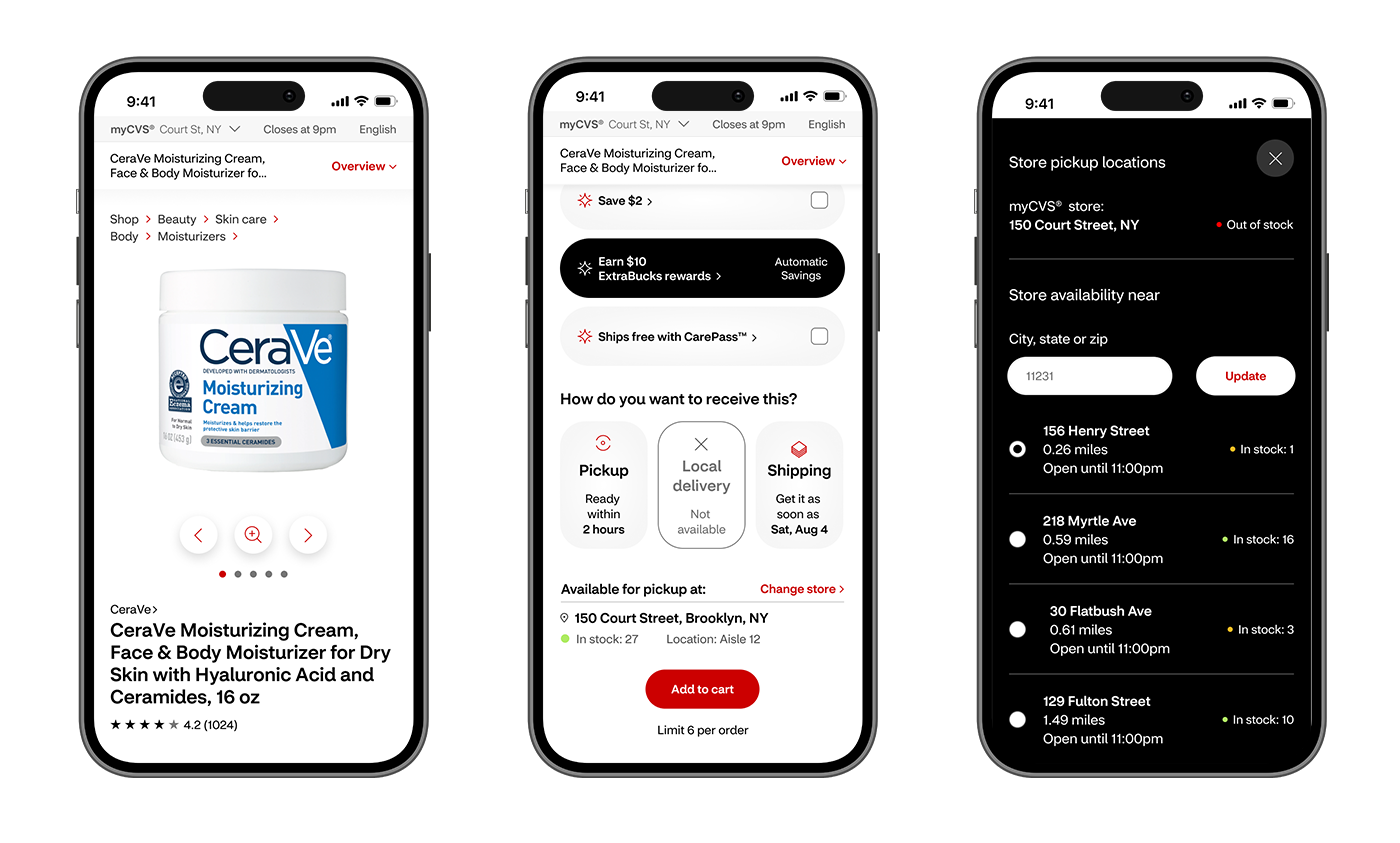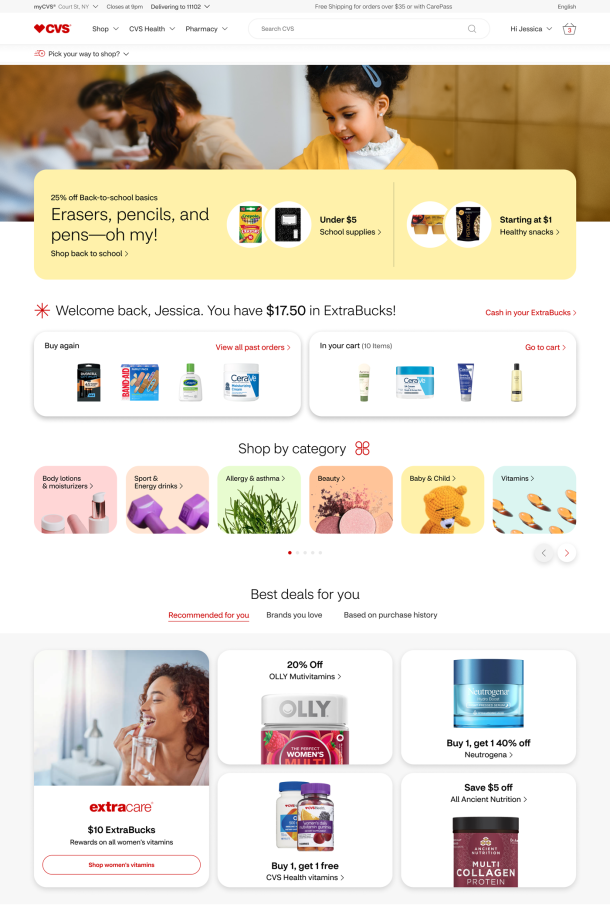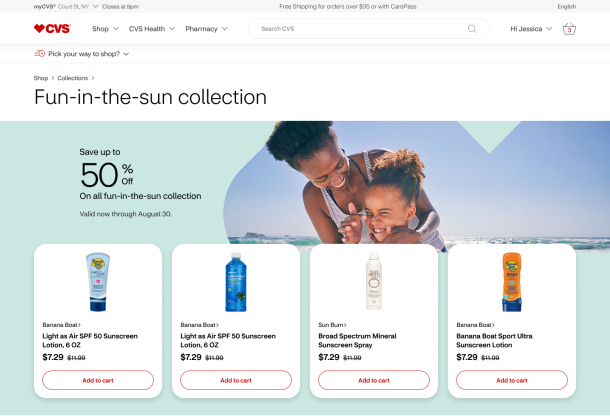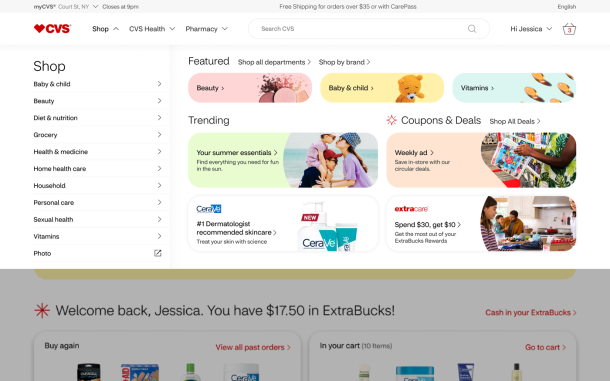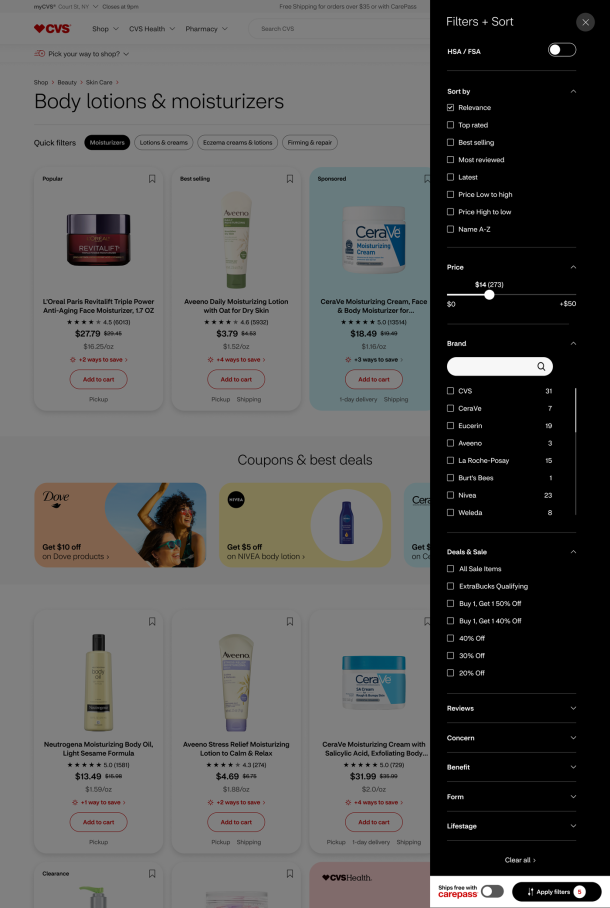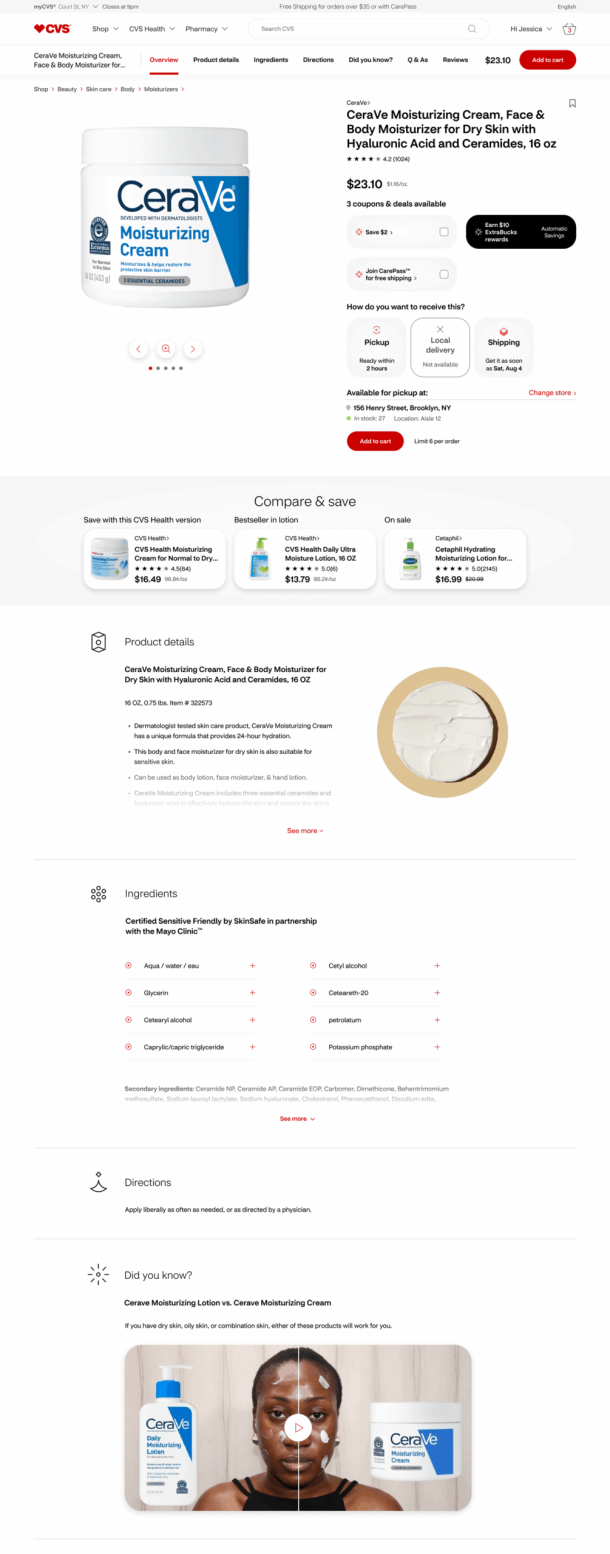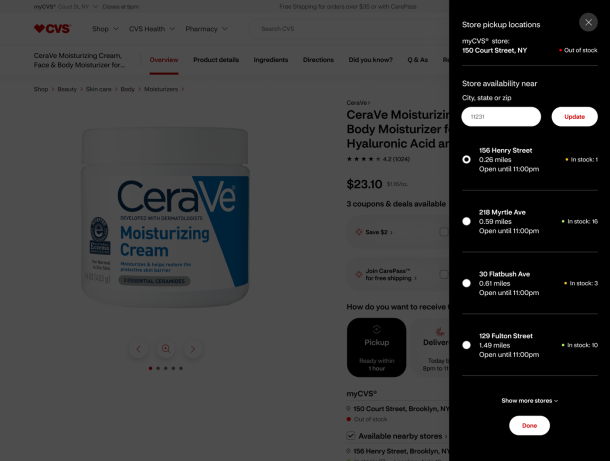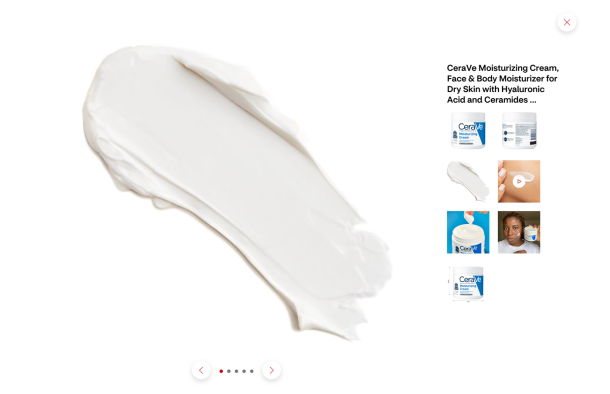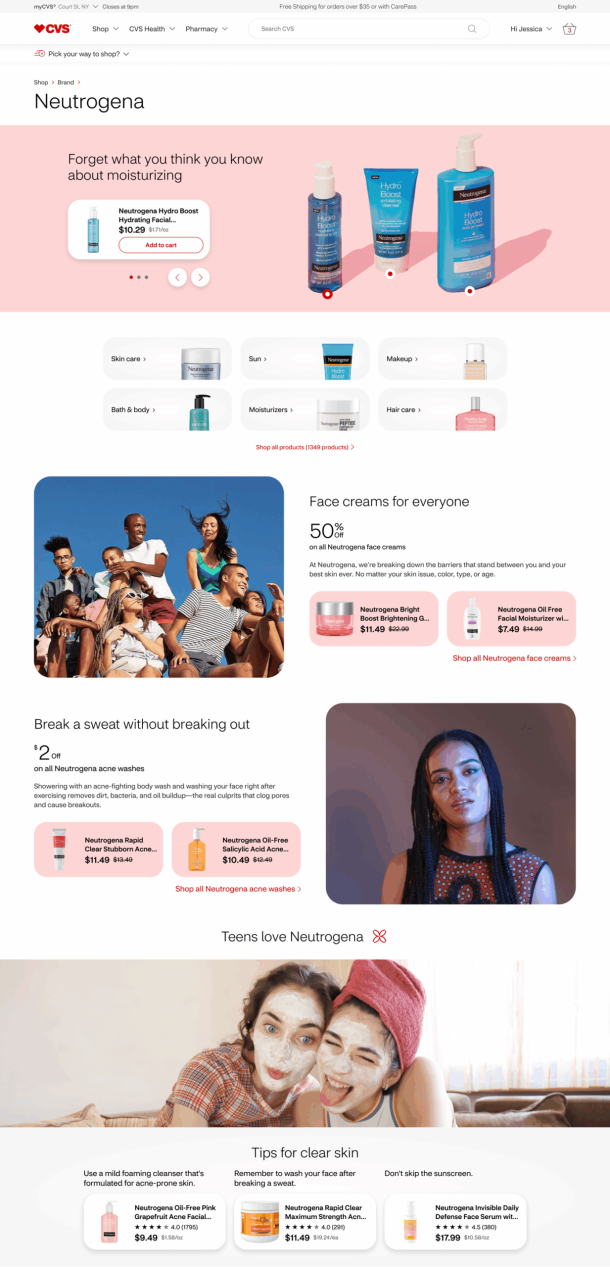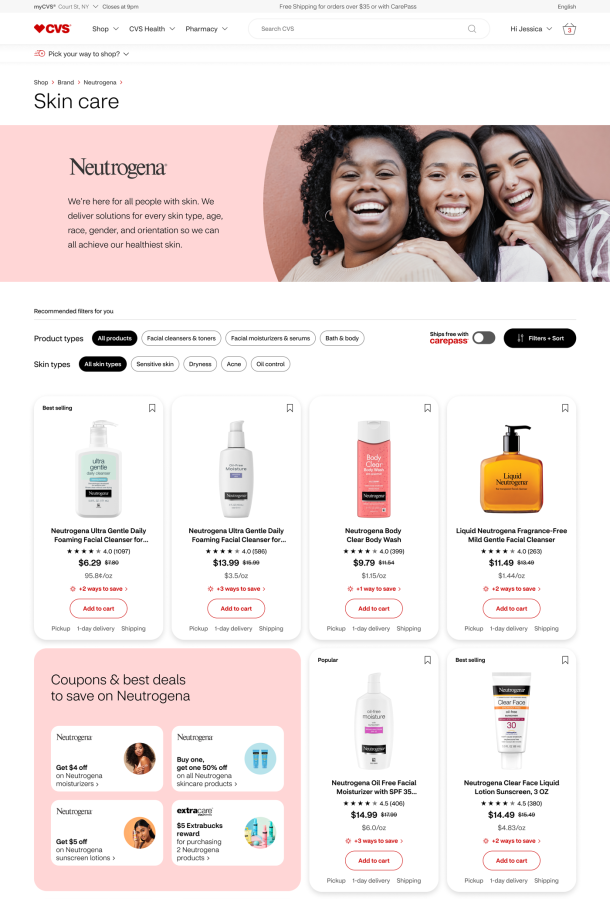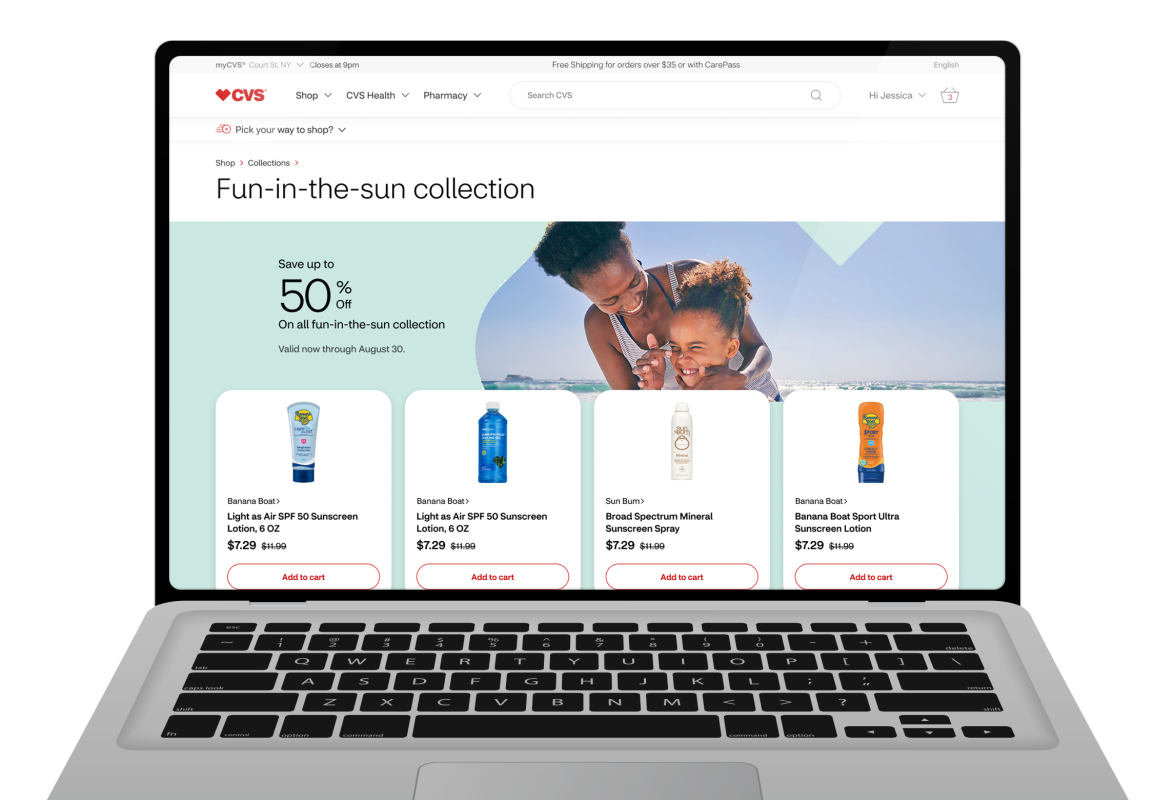
CVS
The client and our initial mission
Everyone’s local drug store, CVS is one of the most recognized health, pharmacy and retail brands in the United States. With nearly $1 billion in online sales in 2022, it’s not a minor player in the e-commerce space, either.
In 2022, Razorfish became CVS’ digital agency-of-record. Our first major project was to stand up a best-in-class e-commerce destination that integrated seamlessly with CVS’ loyal shoppers’ lives, capturing and converting traffic from major local and online retail competitors.
Deliveries
- Product and experience research
- User Journeys
- Product & experience strategy
- Responsive web e-commerce
CVS Health & Pharmacy
E-commerce
Responsive Web Sites
ECD, Experience Design (SVP)
2022 – 2023
Expected challenges
Bidding for the initial scope of work, the CVS pitch team shared hesitations about taking the retailer and health services provider on a client. Within the agency community, CVS had earned the notorious reputation of being very difficult to work with. As a client they had been spectacularly dropped by a number of well respected and highly effective agencies.
With an e-commerce effort that inevitably would impact every aspect of the organization, we knew many executive eyes would be focused on our efforts. If we won the pitch, we’d need to do some heavy preparation and contingency planning — as the agency team — managing a client where in-house executive stakeholders championed competing, often incompatible visions.
-
Jump To
Casting an extensive team
Pre-pandemic, CVS had a physical retailer footprint of nearly 10,000 stores across the United States. Though their individual stores are not as large as say, a Target or Wal-mart, e-commerce experiences for retailers with such huge retail footprints are extensive.
Consequent to the COVID pandemic, CVS (like many retailers) was forced to pivot, leaning more heavily on their online shopping experiences. As part of that pivot, they also needed to strengthen their delivery and fulfillment options, hastily adding new features, such as curbside pick-up and direct-to-consumer delivery. With the redesign, user experience for these services would need to be re-hauled.
This project was gargantuan, given the extensive collection of products, features and integrations we’d need to solve for. We needed to cast an extensive agency-team featuring deep roster of expertise and skills:
Our Agency Team
• 2x Account Executives
• Production Director
• 2x Producers
• ECD, Experience Design (me)
• Creative Director, UX
• UX Lead
• 2x Senior UX designers
• ECD, Creative
• Creative Director
• Associate Creative Director
• Design Lead
• 2x Senior Designers
• CD, Copy
• 2x Copywriters
• SVP, Product Management
• Business Analyst
• EVP, Strategy
• Director of Strategy
• VP, Content Strategy
• Content strategist
• Lead Developer
• AEM Developer
• Accessibility Consultant
Challenge Manifest
We planned rigorously with our our day-to-day client stakeholders, agreeing to pursue a typical review and approval cycle: UX artefacts > Visual design
The review cycle was initially built to have 2 rounds of review and approval by our day-to-day stakeholders prior to presenting to CVS’ executive review committee consisting of their Chief Marketing Officer, Chief Design Officer and the Head of Product Management — 3 company leaders who very rarely shared the same space.
Our first executive review quickly went off the rails, forcing a work-stoppage and requiring several frustrating debriefs for the agency team.
“I don’t want to see wireframes. Show me pictures.”
Norman d.G., Chief Marketing Officer
While we anticipated difficulties managing this client, we assumed that CVS, as a company that implemented design thinking and solutioning internally (they have an internal creative agency, called HeartHaus), would be familiar with a waterfall design process.
Not only were we informed that UX artefacts were not to be shown during review, we also learned our executives had not aligned their respective goals.
The Pivot and Standing Up for Success
Several weeks of planning, internal to the Razorfish team and negotiations around a now impacted and compressed delivery timeline forced our team to rethink how we were going to approach this client.
Our team had already collectively committed hundreds of hours of work in order to arrive at the executive review, only for the work to fall flat. Morale can sometimes be a slippery slope and questions swirled about potentially having to re-do UX that had been hard negotiated, a possible momentum killer.
Revisiting a recording of the executive review, we realized that feedback was almost exclusively focused on presentation and not our thinking. Our UX was solid and well informed, and, despite the poor feedback, we ultimately realized that we needed to lead with visual design for our executive review.
Discipline leaders such as myself took further steps and worked with our day-to-day client stakeholders to understand how CVS operated creatively. We approached CVS’ Chief Design Officer to understand the role UX played in the organization and ultimately came to the agreement that it was ok to keep UX reviews to day-to-day stakeholders, and, that presenting near-final creative to executives, we needed to advocate for UX during those sessions.
This did have major impacts to our process, agencies typically work in waterfall, and we were now implementing a lean-in process, which honestly, was exciting for team culture and collaboration, not to mention, far more efficient.
Nearly three weeks after the initial review, we arrived once again at executive review ready to present our work.
“Excellent work! I really appreciated your efforts to meet my limitations. No one we’ve ever worked with has ever taken the time to demystify user experience the way you have. Thank you.”
Norman d.G., Chief Marketing Officer
Similar Projects


